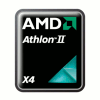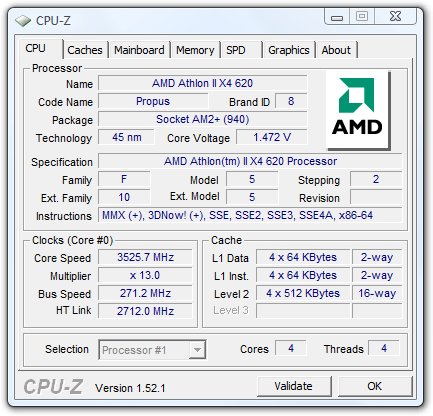- Qualcomm Launches Snapdragon 4 Gen 2 Mobile Platform
- AMD Launches Ryzen PRO 7000 Series Mobile & Desktop Platform
- Intel Launches Sleek Single-Slot Arc Pro A60 Workstation Graphics Card
- NVIDIA Announces Latest Ada Lovelace Additions: GeForce RTX 4060 Ti & RTX 4060
- Maxon Redshift With AMD Radeon GPU Rendering Support Now Available
AMD Athlon II X4 620 – Quad-Core at $99

Last month, AMD became the first company to bring a $99 quad-core processor to market, the Athlon II X4 620. The question, of course, is whether or not it delivers. At 2.60GHz, it looks to offer ample performance, but the lack of an L3 cache is sure to be seen in some of our tests. Luckily, the chip’s overclocking-ability helps negate that issue.
Page 10 – Overclocking the Athlon II X4 620
Before discussing results, let’s take a minute to briefly discuss what I consider to be a worthwhile overclock. As I’ve mentioned in past content, I’m not as interested in finding the highest overclock possible as much as I am interested in finding the highest stable overclock. To me, if an overclock crashes the computer after a few minutes of running a stress-test, it has little value except for competition.
How we declare an overclock stable is simple… we stress it as hard as possible for a certain period of time, both with CPU-related tests and also GPU-related, to conclude on what we’ll be confident is 100% stability throughout all possible computing scenarios.
For the sake of CPU stress-testing, we use IntelBurnTest, for reasons I’ve laid out in a recent forum thread. Compared to other popular CPU stress-testers, IBT’s tests are far more gruelling, and proof of that is seen by the fact that it manages to heat the CPU up to 20°C hotter than competing applications, like SP2004. Also, despite its name, IntelBurnTest is just as effective on AMD processors. Generally, if the CPU survives the first half-hour of this stress, there’s a good chance that it’s mostly stable, but I strive for a 12 hour stress as long as time permits.
If the CPU stress passes without error, then GPU stress-testing begins, in order to assure a system-wide stable overclock. To test for this, 3DMark Vantage’s Extreme test is used, with the increased resolution of 2560×1600, looped nine times. If this passes, some time is dedicated to real-world game testing, to make sure that gaming is just as stable as it would be if the CPU were at stock. If both these CPU and GPU tests pass without issue, we can confidently declare a stable overclock.
Overclocking the Athlon II X4 620
After I finished up benchmarking the X4 620, I contemplated whether or not I should even bother attempting to overclock the chip. The reason is this. This is not a chip designed for overclocking, and its target audience isn’t even close. I also assumed that it simply wasn’t going to overclock, given the luck I’ve had in recent months with Phenom II’s (due to heat). But, I decided it made sense to at least give it a try, because, who knows, right?
Boy, am I glad I decided to see what this puppy was made of! It exceeded my overclocking expectations by a large margin, I can honestly say, and while I was overclocking it, it felt like I was overclocking a recent Intel chip, because it was just that easy (no offense to AMD’s chips… I’ve just had horrible luck with them). I first cranked the chip up to 3.0GHz, and it was absolutely stable. So I decided to push it further… to 3.2GHz, then 3.3GHz, and sure enough… still stable.
When all said and done, I got the X4 620 up to 3.53GHz, stable. That in itself is sweet, but even sweeter is the fact that this overclock required absolutely no user-managed voltage increase. As you can see in the below shot, the board itself increased the voltage, about 0.1v. I won’t lie… that voltage is rather high, but given the stock voltage is 1.375v, and the overclocked is 1.475v, it’s not exactly a major jump.
I should also reiterate the fact that this overclock was achieved with the ASUS M4A785TD-M EVO mATX motherboard. Not a bad clock speed for $200 (board + chip), huh?
How does our overclock translate into real-world results?
|
AMD Athlon II X4 620 2.60GHz (Overclock: 3.53GHz)
|
|||
|
Benchmark
|
Stock
|
Overclock
|
Increase
|
| Autodesk 3ds Max 2009 Dog Render Bathroom Render |
358 s
726 s |
268 s
540 s |
33.58%
34.44% |
| Cinebench R10 Single-Thread Multi-Thread |
2802
9900 |
3799
13361 |
35.58%
34.96% |
| POV-Ray 3.7 Single-Thread Multi-Thread |
603.82
2352.86 |
812.80
3185.61 |
34.61%
35.39% |
| Adobe Lightroom 2.0 Convert 100 RAW to JPEG |
184.34 s
|
141.34 s
|
30.42%
|
| TMPGEnc Xpress HD Video Encode Mobile Video Encode |
355 s 152 s |
287 s 118 s |
23.69% 28.81% |
| ProShow Gold HD Video Encode DVD Video Encode |
131 s 568 s |
97 s 428 s |
35.05% 32.71% |
| Sandra Arithmetic Dhrystone SSE4.2 Whetstone SSE3 |
39100 MIPS 30069 MFLOPS |
51753 MIPS 40413 MFLOPS |
32.36% 34.40% |
| Sandra Multi-Media Int x16 Float x8 Double x4 |
121.00 MPixel/s 73.39 MPixel/s 40.11 MPixel/s |
162.63 MPixel/s 98.87 MPixel/s 54.17 MPixel/s |
34.40% 34.72% 35.05% |
| Sandra Cryptography AES256 SHA256 |
390 478 |
524 643 |
34.36% 34.52% |
| Microsoft Excel Monte Carlo Big Number Crunch |
46.441 s 18.47 s |
34.663 s 13.868 s |
33.98% 33.18% |
The results really do speak for themselves. Our 35% increase to the processor’s clock speed actually did result in the same gain in almost all of our benchmarks, the few exceptions being with TMPGEnc Xpress. Considering that this overclock was “free”, in that it required no effort and is 100% stable, the performance here is incredible.
It should be noted that while I hit 3.53GHz, I quit while I was ahead, because I felt that to be an ideal clock speed given the effort. Any further, and I’m sure I’d have to start manually cranking the voltage to unsafe levels. Either way you look at it, this is a 35% overclock that took no effort to pull off, and it was done on a $95 motherboard, so chances are good that you’ll be able to achieve an equal, if not better, overclock in your own testing.
Support our efforts! With ad revenue at an all-time low for written websites, we're relying more than ever on reader support to help us continue putting so much effort into this type of content. You can support us by becoming a Patron, or by using our Amazon shopping affiliate links listed through our articles. Thanks for your support!






